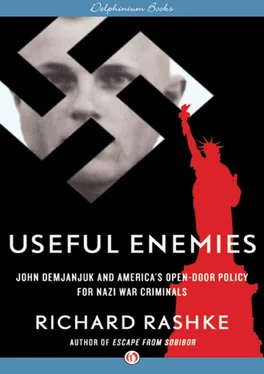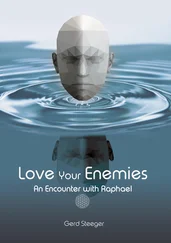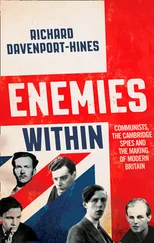In November 1965, a Riga court tried Maikovskis and four others Latvians in absentia and sentenced them to death. The United States declined to extradite Maikovskis. Of course the CIA wanted to protect Maikovskis. Through Radio Free Europe and Radio Liberty (RL), the agency had illegally laundered up to a billion dollars, which it funneled to the Latvian organizations Maikovskis spied on as well as to scores of other anticommunist émigré groups. Deportation hearings on Maikovskis might accidently expose the CIA’s illegal use of funds and place it under the microscope of a congressional investigation. The United States was at war. What choice did Langley have but to shield Maikovskis?
• • •
The subject of DeVito’s other whistle-blower case was Tscherim Soobzokov, a Russian from Circassia, a mountainous region of the Soviet Union between the Black and Caspian seas. Like Maikovskis, Soobzokov was a lieutenant in a Circassian unit of the Waffen SS (armed SS), which he helped organize to fight the Red Army. The Displaced Persons Commission ruled that the Waffen SS was inimical and barred its members from the United States.
After the war, Soobzokov made his way to the United States and was living in Paterson, New Jersey, where he worked as Passaic County’s chief purchasing inspector. He soon became a leader in Circassian American organizations.
Reuben Fier, a retired New York City cop-turned-investigator for the Social Security Administration, stumbled on Soobzokov’s Nazi background while checking a complaint that Soobzokov was bribing someone in the SSA to accept forged birth certificates of fellow Circassians, making them eligible for Social Security benefits.
For the next three years, Fier used all his cop savvy and government clearances to compile a fat dossier on Soobzokov. Armed with enough information to have the Nazi collaborator stripped of his U.S. citizenship and deported, Fier approached the New Jersey INS office. It treated him to a bum’s rush. When he read about DeVito’s work on the Braunsteiner case, Fier offered him the dossier.
After reading Fier’s file, DeVito pronounced Soobzokov a slam dunk. Since the man lived outside his New York jurisdiction, DeVito gave the file to the New Jersey office, investigator to investigator. When he called a few weeks later to check on the status of the case, he was greeted with “What file?” There was a dossier filed under S, all right, but it was empty.
What DeVito didn’t know in 1973, but probably suspected, was that the CIA had also recruited Tscherim Soobzokov. They first noticed him in Amman, Jordan, where he finally settled after the war. For him, Jordan was a logical choice. It was the home of a deeply rooted Circassian Muslim community of eighteen thousand that dated back to the late 1800s.
The CIA noted several characteristics about Soobzokov that made him a good prospect. He was bitterly anticommunist, a leader in the Circassian community (both feared and respected), and nearly destitute, with little hope of ever finding a well-paying job. The CIA also noted that he liked to show Jordanian Arabs his Einsatzgruppe ID card and brag about how many Jews he had killed, according to recently released CIA files.
Soobzokov was eager to work for the CIA, especially since it assured him that it didn’t care if he had a war crimes history or had committed “moral lapses.” Most important, the agency suggested that U.S. citizenship was always possible after his tour of duty. As part of its vetting process, the CIA put Soobzokov through a series of polygraph tests in its Beirut safe house to find out what he did during the war and how it could best use him as a clandestine operative.
After the vetting, the CIA gave Soobzokov the code name Nostril and trained him as a “spotter” in Operation Redsox, a joint American and British espionage operation. The agency housed, fed, clothed, and paid him. His job was to look for communist sympathizers among his fellow Circassians and to identify those who were so anticommunist—or desperate for money—that they would be willing to sneak back into their home country and perform dirty tricks for the CIA as assassins and saboteurs. Soobzokov himself went on at least one spy mission to the Soviet Union.
When his two-year contract was up, the CIA disbanded Redsox in Jordan, cut Soobzokov loose, and arranged for him to emigrate to America. It settled him in New Jersey, which had a small Circassian community, and before long his house became the meeting place for local and international Circassian leaders.
The CIA reemployed Soobzokov briefly and recommended his services to the FBI. The agencies sent him to the national intelligence center at Fort Meade, Maryland, outside Washington, for specialized training as a “Hot War Agent.” He studied clandestine field craft and leadership. After graduation, the CIA sent him back to Jordan for three months, this time to spot, train, and send Circassian agents across the border into Syria.
The CIA decided to cut Soobzokov loose permanently in 1960 because of “discrepancies” in his war biography that he couldn’t clarify. That was bureaucratese for “the guy was a liar.” He continued to do odd jobs for the FBI, supplying the bureau with “valuable information on numerous” individuals of interest.
Naturally, when DeVito began sniffing around Soobzokov’s Nazi background, Washington got very nervous. The FBI and CIA were still running illegal clandestine operations in the early 1970s and they needed to make the Soobzokov investigation go away.
• • •
The Maikovskis and Soobzokov cases pushed DeVito over the edge. As a Nazi investigator, he felt trapped inside a vicious circle. The INS had blocked his every move in three Nazi collaborator cases. The agency failed to investigate itself with even a show of integrity. The FBI either looked the other way or gave the INS a cursory glance and pronounced it clean. And the Justice Department itself seemed to be working for the other side.
Disgusted and bruised, DeVito told his boss to go to hell and took early retirement. Then he and Schiano teamed up to play their trump card. Using media pressure had worked in the past, maybe it would again. They described to the New York Times , point by point, how their boss Sol Marks and his Washington shadow-superior had “hampered” their investigation into, and prosecution of, Hermine Braunsteiner.
Brushing their allegations aside like a piece of lint, Marks simply dismissed DeVito and Schiano as “romantics.” If he expected the issue to go away, he was wrong. The Times article about DeVito, Schiano, and the government’s obstruction of the Braunsteiner case became the third domino to topple in the row leading to John Demjanjuk.
CHAPTER SEVEN
The Fourth Domino
Elizabeth Holtzman smelled a rat. A representative from Brooklyn and the youngest woman ever elected to Congress, she was in office only a few months when she got an anonymous phone call from a mid-level INS bureaucrat requesting a confidential meeting. The man was calling her because she was both Jewish and a member of the House Subcommittee on Immigration, which monitored the workings of the INS. Not sure what to expect, Holtzman invited her administrative assistant to sit in as a witness. The year was 1973. Schiano had just quit and DeVito had just retired.
“There is a matter that is troubling me greatly,” the man said. He did not give his name and Holtzman did not ask for it. “The Immigration Service has a list of Nazi war criminals living in America, and it is doing nothing about them.”
Holtzman didn’t know what to think. The whistle-blower was clearly agitated and appeared deeply ashamed of what he considered an INS cover-up. Holtzman could almost feel his moral outrage. Of Armenian descent, the man was no stranger to ethnic cleansing. The Turks had systematically murdered more than one million of his ancestors before and during World War I.
Читать дальше












